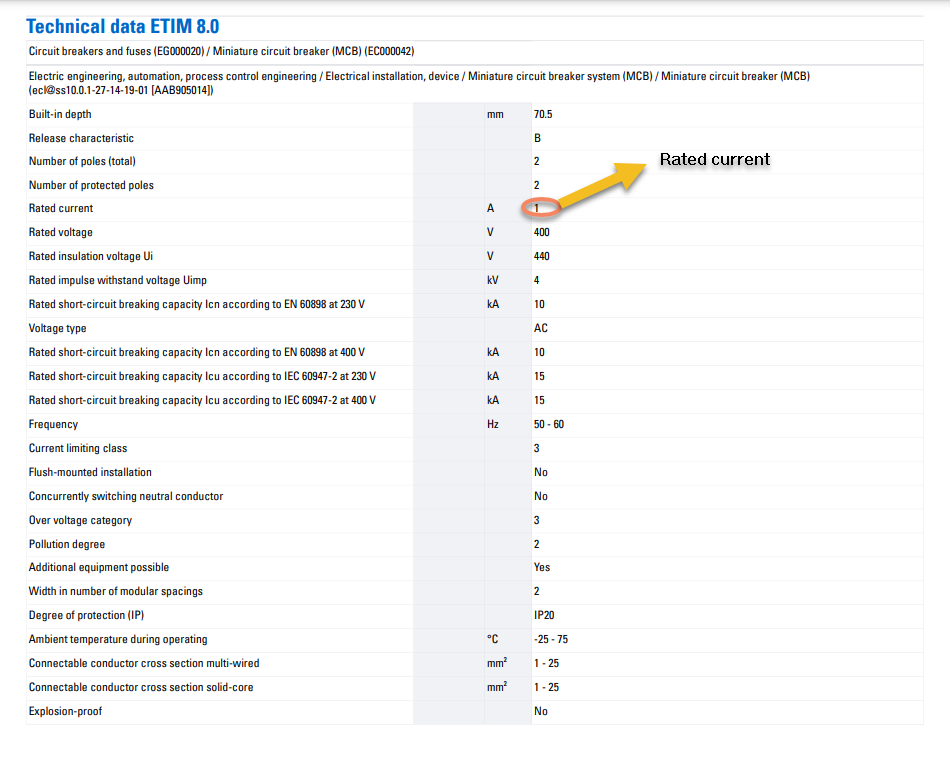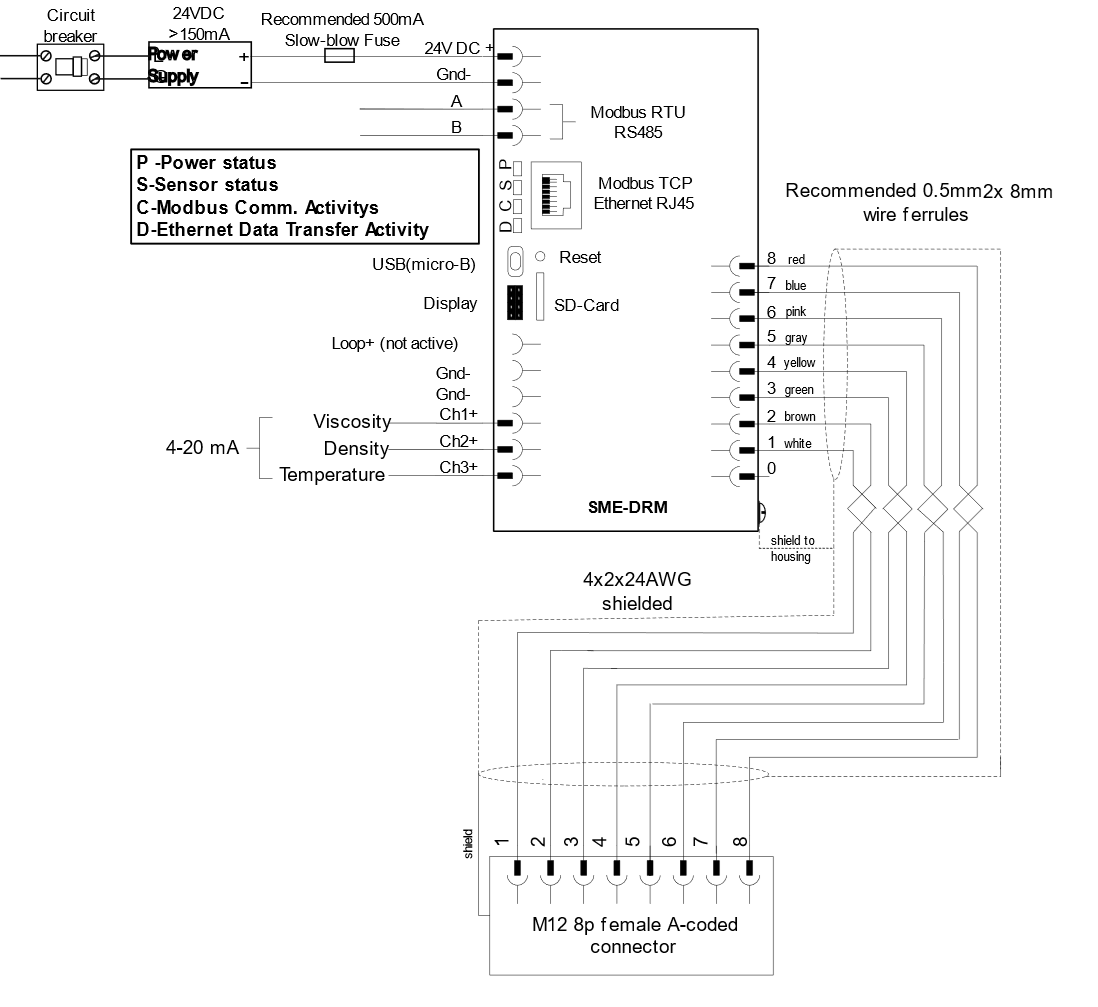What is a circuit breaker?
Circuit breakers interrupt the current of an overloaded electric circuit, ground fault, or short circuit when they sense an overload. As soon as a fault is detected, circuit breakers trip, shutting off current flow. In most cases, circuit breakers do not need to be replaced because they are not damaged.

TABLE OF CONTENTS
- What is a circuit breaker?
- 1. How to size a circuit breaker to protect the Rheonics SME?
- 2. Recommended circuit breakers
- 3. Sizing cable wire that goes from the circuit breaker to the power supply.
- 4. Resources
1. How to size a circuit breaker to protect the Rheonics SME?
It is important to select a circuit breaker for a device based on the maximum current it will draw. The Rheonics SME operates and draws a current of 120mA.
When selecting a circuit breaker for Rheonics SME, here are some recommendations:
Determine the maximum current load of the circuit. Rheonics SME draws 120mA current, so selecting a circuit breaker with a recommended rated operational current that is 33% above this value is good enough.
Select a breaker with a current rating equal to or greater than the maximum current load of the circuit. To properly select a circuit breaker we need to check its datasheet.

Observe that with a 1A-rated current, this circuit breaker can sustain the 120mA current required by our electronics. The circuit breaker should also be capable of operating at the rated voltage of the power supply, our SME operates at 24V DC.
 Figure 3. Rheonics SME wiring diagram.
Figure 3. Rheonics SME wiring diagram.
Select a breaker that is compatible with the electrical system and the power supply. It may be necessary to consult with an electrician or electrical engineer or to look at the manufacturer's specifications for the breaker and the electrical system.
2. Recommended circuit breakers
2.1. ABB S200
The S200 series is designed to protect installations from overloads and short circuits, ensuring reliability and safety under all operating conditions. Miniature circuit breakers (MCBs) are designed to be modular, meaning they can be easily snapped into standard DIN rail-mounted enclosures or distribution boards.
 Figure 4. ABB Circuit Breaker M201-1A[2]
Figure 4. ABB Circuit Breaker M201-1A[2]
2.2. Schneider Electric C60
The C60 series from Schneider Electric is designed for use in low-voltage electrical installations to protect circuits and electrical equipment from overcurrents and short circuits.
 Figure 5. Schneider Electric circuit breaker M9F42201 [3]
Figure 5. Schneider Electric circuit breaker M9F42201 [3]
2.3. Eaton FAZ-B1/2
The Eaton FAZ-B1/2(Figure 1) is a miniature circuit breaker (MCB) designed for electrical distribution panels and enclosures to protect circuits and electrical equipment from overcurrents and short circuits.[1]
3. Sizing cable wire that goes from the circuit breaker to the power supply.
Sizing wires appropriately for a wide range of applications can be a challenging and daunting task. Amperage serves as the gauge for the electrical current coursing through a circuit. The ampacity rating of a wire is what dictates the maximum safe amperage it can accommodate. To effectively determine the right wire size for your specific needs, it's crucial to have a grasp of wire ampacity ratings. Nevertheless, several external factors, including ambient temperature and conductor insulation, contribute to determining a wire's ampacity.
The calculation of wire ampacity is structured to ensure that it doesn't exceed a specified temperature increase under a given electrical load.
3.1. Power load of Rheonics SME
The general rule of thumb is that the cable size should be higher than the maximum load the circuit breaker can operate (This is to guarantee that the breaker will trip before the cable starts burning).
It is important to take into consideration the following aspects[4]:
Current carrying capacity also referred to as ampacity, describes how much electric current can be safely carried by a cable or conductor without exceeding its temperature rating.
Voltage drop occurs when current flows through cables or conductors, resulting in a reduction in voltage (potential difference). Voltage drops at the load end can cause electrical equipment to malfunction if the voltage levels are inadequate.
Short circuit rating describes a cable's or conductor's ability to withstand high currents generated during a short circuit event without failing.
Mechanical strength is the ability of the cable to withstand physical stresses and external forces without compromising its electrical properties.
Based on our selection a 1A Circuit breaker can be used with cable caliber 16AWG or 18 AWG based on the table from below.
| Wire gauge | Ampacity |
| 12 AWG | 20 Amps |
| 14 AWG | 15 Amps |
| 16 AWG | 13 Amps |
| 18 AWG | 10 Amps |
Table 1. ABYC Ampacity Rating Table at 30°C[6]
4. Resources
EATON Circuit breaker - FAZ-B1/2 [1]
ABB Circuit breaker - M200 range [2]
Multi9 Schneider Electric Circuit breaker [3]
Electrical Cable Size Calculator and BS7671 Wire Sizing Chart [4]
 Allowable Amperage in Conductors - Wire Sizing Chart - Blue Sea Systems [6]
Allowable Amperage in Conductors - Wire Sizing Chart - Blue Sea Systems [6]
 Wire preparation for SME-TR/TRD (Outdoor Mount) [7]
Wire preparation for SME-TR/TRD (Outdoor Mount) [7]
 Selectivity among fuses or between fuses and circuit breakers [8]
Selectivity among fuses or between fuses and circuit breakers [8]

